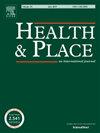Association between ambient temperatures and cardiovascular disease: A time series analysis using emergency ambulance dispatches in Chongqing, China, 2019–2021
IF 3.8
2区 医学
Q1 PUBLIC, ENVIRONMENTAL & OCCUPATIONAL HEALTH
引用次数: 0
Abstract
Background
Cardiovascular disease (CVD) is one of the leading causes of death globally. Yet, further research is required into the relationship between CVD and extreme environmental temperatures. This study aims to explore the association between the incidence of CVD and extreme temperatures, and also to identify susceptible subgroups within the population.
Methods
We collected cardiovascular emergency ambulance dispatch (CEAD) records from Chongqing Emergency Dispatch Center in the main urban areas of Chongqing from 2019 to 2021. Then, we used distributed lag nonlinear modeling (DLNM) with a quasi-Poisson distribution to evaluate the association between extreme temperatures and CEADs. Susceptibility subgroups were identified by stratified analysis according to gender, age and initial diagnosis. Finally, the attribution analysis was used to calculate the scores and counts of CEADs caused by low and high temperatures.
Results
Compared with the optimal temperature (23 °C), the cumulative lagged risk of total CEADs was increased under extreme low-temperature conditions (CRR: 1.732, 95% CI: [1.157, 2.593]), with the lagged effect lasting for 8 days. Under extreme high-temperature conditions, it decreased (CRR: 0.752, 95% CI: [0.611, 0.926]) and a protective effect was observed. Compared to the group under 60, those over 60 were more sensitive to temperature changes, showing a higher risk of disease with cold exposure (RR: 1.087, 95% CI: [1.021, 1.157]). In addition, a reduction in risk of disease was observed just one day after heat exposure. There were also gender differences in the elderly group: males showed longer lagged effects after cold exposure, while females had higher dispatch risk in cold weather and less heat adaptation in hot weather than males.
Conclusion
Ambient temperature is significantly associated with the risk of CVD, with elderly patients, especially females, being a high-risk subgroup. Governments need to formulate localized health policies that address regional climate patterns and population vulnerabilities. As one of the famous "Furnace Cities", Chongqing's measures for coping with hot environments can serve as a reference. Nonetheless, improving our understanding and preparation for cold weather is also crucial. Public warning systems should be improved, and local heating strategies for vulnerable groups should be developed to minimize the negative risk of extreme cold temperatures to the public.
环境温度与心血管疾病的关系:2019-2021年中国重庆紧急救护车调度的时间序列分析
背景:心血管疾病(CVD)是全球死亡的主要原因之一。然而,需要进一步研究CVD与极端环境温度之间的关系。本研究旨在探讨心血管疾病发病率与极端温度之间的关系,并确定人群中的易感亚群。方法:收集重庆市急救调度中心2019 - 2021年在重庆市主城区心血管急诊救护车调度(CEAD)记录。然后,我们使用准泊松分布的分布滞后非线性模型(DLNM)来评估极端温度与cead之间的关系。根据性别、年龄和初诊情况进行分层分析,确定易感亚组。最后,采用归因分析方法计算低温和高温引起的cead的得分和计数。结果:与最适温度(23℃)相比,极低温条件下总CEADs累积滞后风险增加(CRR: 1.732, 95% CI:[1.157, 2.593]),滞后效应持续8天。在极端高温条件下,其降低(CRR: 0.752, 95% CI:[0.611, 0.926]),具有保护作用。与60岁以下人群相比,60岁以上人群对温度变化更敏感,冷暴露的患病风险更高(RR: 1.087, 95% CI:[1.021, 1.157])。此外,热暴露后仅一天就观察到疾病风险的降低。老年组也存在性别差异:男性在冷暴露后表现出较长的滞后效应,而女性在寒冷天气下的调度风险高于男性,在炎热天气下的热适应能力低于男性。结论:环境温度与心血管疾病发生风险显著相关,老年患者,尤其是女性患者为高危亚群。各国政府需要制定针对区域气候模式和人口脆弱性的地方卫生政策。作为著名的“炉城”之一,重庆应对高温环境的措施值得借鉴。然而,提高我们对寒冷天气的认识和准备也至关重要。应改进公共预警系统,并为弱势群体制定当地供暖战略,以尽量减少极端低温对公众的负面风险。
本文章由计算机程序翻译,如有差异,请以英文原文为准。
求助全文
约1分钟内获得全文
求助全文
来源期刊

Health & Place
PUBLIC, ENVIRONMENTAL & OCCUPATIONAL HEALTH-
CiteScore
7.70
自引率
6.20%
发文量
176
审稿时长
29 days
期刊介绍:
he journal is an interdisciplinary journal dedicated to the study of all aspects of health and health care in which place or location matters.
 求助内容:
求助内容: 应助结果提醒方式:
应助结果提醒方式:


